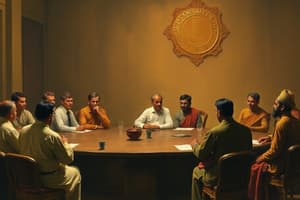Podcast
Questions and Answers
When was the Indian Constitution sworn in?
When was the Indian Constitution sworn in?
- March 8, 1947
- August 15, 1947
- January 24, 1950 (correct)
- January 26, 1950
Who headed the committee that drafted the Indian Constitution?
Who headed the committee that drafted the Indian Constitution?
- Dr. B.R. Ambedkar (correct)
- Jawaharlal Nehru
- Mahatma Gandhi
- Dr. Rajendra Prasad
Who was the president of India's Constituent Assembly when the Indian Constitution was adopted?
Who was the president of India's Constituent Assembly when the Indian Constitution was adopted?
- Dr. Rajendra Prasad (correct)
- Jawaharlal Nehru
- Mahatma Gandhi
- Dr. B.R. Ambedkar
Who was elected the first president of India?
Who was elected the first president of India?
Which judicial body does the Indian Constitution establish as the highest in the country?
Which judicial body does the Indian Constitution establish as the highest in the country?
What type of government does the Indian Constitution provide for?
What type of government does the Indian Constitution provide for?
Flashcards are hidden until you start studying
Study Notes
- On January 26, 1950, India's Constituent Assembly, with Dr. Rajendra Prasad as president, adopted the Indian Constitution.
- India's struggle for independence from British rule and the formation of a new government led to the creation of the Constitution.
- The process of forming the Constitution began during World War II, with the Round Table Conference of 1932 and the Government of India Act of 1935.
- In 1946, the Constituent Assembly held its first meeting in New Delhi, with Mahatma Gandhi absent, and partition discussions leading to the creation of Pakistan.
- Dr. Rajendra Prasad was elected the first president of India, and the Indian Constitution was sworn in on January 24, 1950.
- The Indian Constitution was drafted by a committee headed by Dr. B.R. Ambedkar, who also played a crucial role in its adoption.
- The Indian Constitution is the longest written constitution of any sovereign country in the world.
- The Indian Constitution provides for a parliamentary system of government, with a president, prime minister and parliament, and guarantees fundamental rights and freedoms to all citizens.
- The Indian Constitution also establishes the Supreme Court as the highest judicial body in the country, responsible for interpreting the Constitution and upholding the rule of law.
- The Indian Constitution came into effect on January 26, 1950, and is celebrated as Republic Day in India.
- The Indian Constitution was drafted in Hindi, English, and various regional languages, and was signed by over 280 members of the Constituent Assembly.
- The Indian Constitution was an extraordinary achievement that brought together diverse communities and cultures within a unified framework, making it a unique and valuable contribution to the world of constitutional law.
Studying That Suits You
Use AI to generate personalized quizzes and flashcards to suit your learning preferences.



